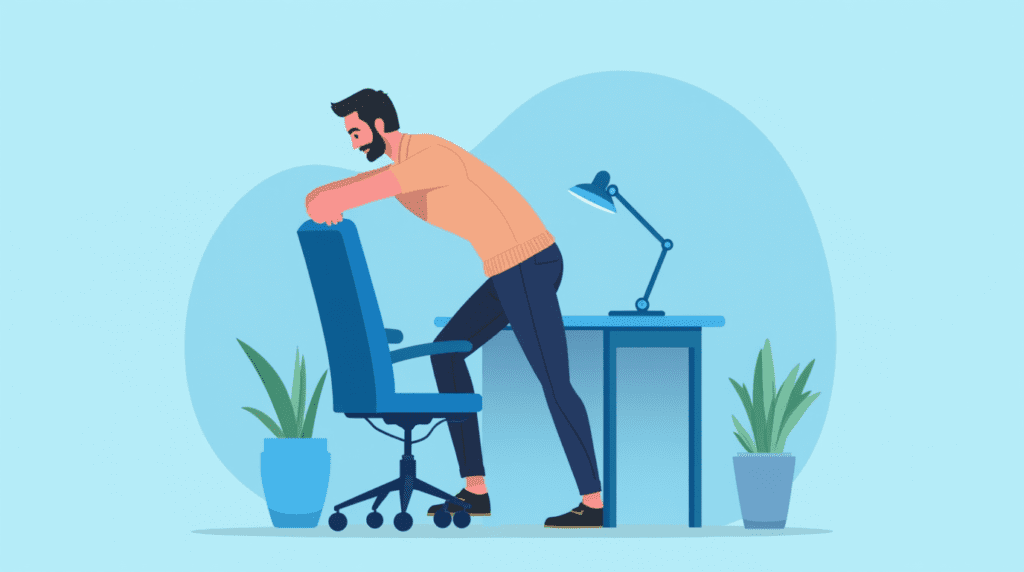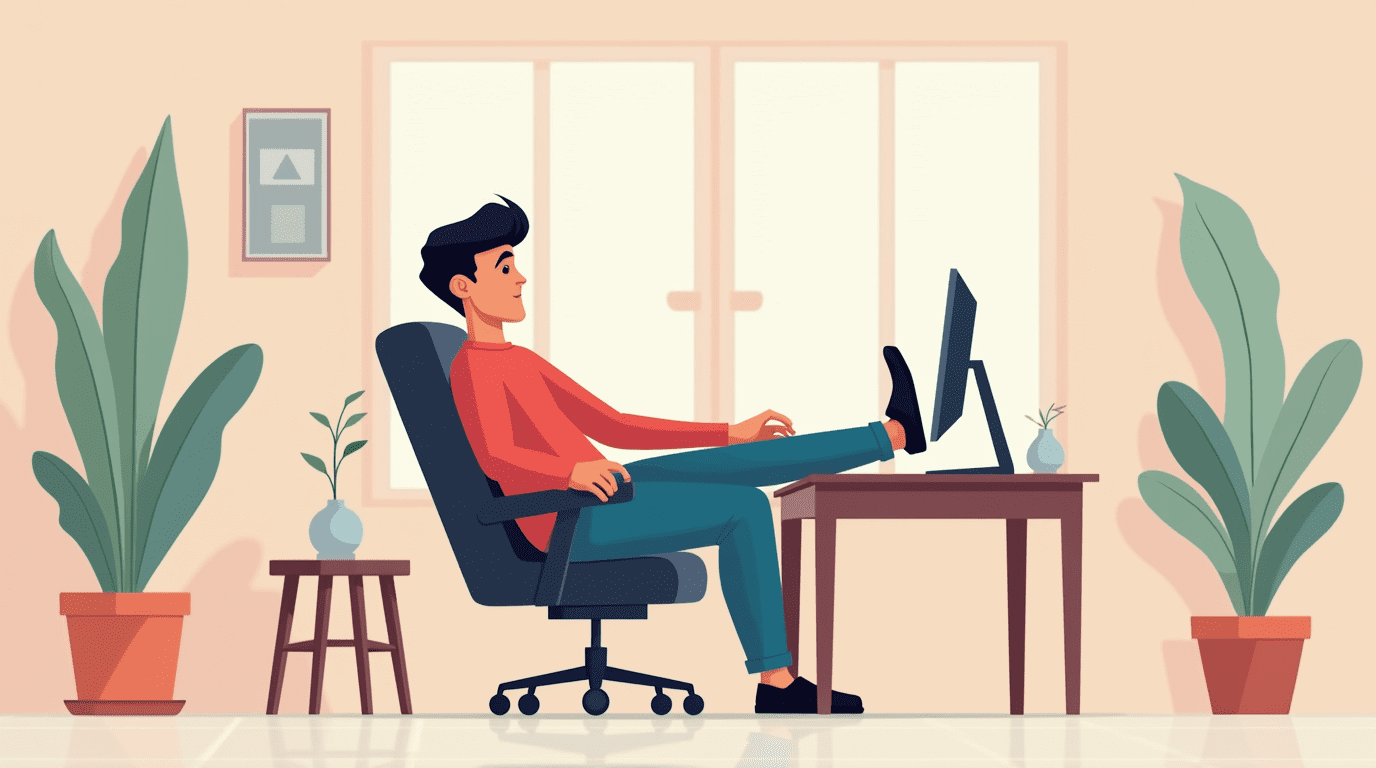Importance of Desk Stretches
For desk workers, incorporating easy desk stretches into their daily routine can make a significant difference. Not only does stretching improve flexibility and reduce muscle tightness, but it also enhances overall comfort and productivity.
Benefits of Stretching
Stretching is beneficial in numerous ways:
- Improves Flexibility: Regular stretching can enhance the range of motion in muscles and joints, making daily activities easier and more fluid.
- Reduces Muscle Tightness: Stretching helps relieve tight muscles, which is especially important for those who spend long hours sitting.
- Increases Circulation: Stretching promotes blood flow to the muscles, which can help reduce fatigue and increase energy levels.
- Enhances Comfort and Productivity: A flexible and comfortable body can improve focus and efficiency at work.
| Benefits of Stretching | Impact |
|---|---|
| Flexibility | Increases range of motion |
| Muscle Tightness | Reduces tension |
| Circulation | Boosts blood flow |
| Comfort/ Productivity | Enhances work efficiency |
For more stretches targeting specific areas, check our sections on desk stretches for lower back and desk stretches for neck and shoulders.
Impact of Prolonged Sitting
Prolonged sitting has several adverse effects on health:
- Muscle Discomfort: Sitting for extended periods can lead to tightness and discomfort in muscles such as the back, shoulders, and neck.
- Health Issues: Extended inactivity is associated with various health problems, including weight gain and cardiovascular issues.
- Reduced Productivity: Sitting in the same position for hours can cause fatigue and reduce productivity.
Research shows that at least 8 in 10 American workers stay in one spot while doing repetitive desk tasks, contributing to discomfort and health issues (Healthline)
Regular breaks to stand and stretch can mitigate these negative effects. Such breaks have been shown to increase productivity, reduce neck and shoulder pain, and lessen headaches and tension (Verywell Fit). For creative desk stretches that can help, check out our article on seated desk stretches.
Incorporating these simple yet effective stretches into your daily routine can have a big impact on your health and work performance.
Neck and Shoulder Stretches

Prolonged sitting and working at a desk can lead to strain and discomfort in the neck and shoulders. Incorporating simple stretches into the daily routine can alleviate tension and improve overall wellbeing. Here are some effective exercises to keep your neck and shoulders relaxed and flexible.
Neck Release Stretch
The Neck Release Stretch is effective for reducing tension in neck muscles and improving flexibility. This stretch is essential for desk workers who often spend long hours hunched over their computers. Desk stretches for neck and shoulders provide a more detailed explanation.
How to Perform:
- Sit up straight in your chair.
- Gently tilt your head to one side, bringing your ear toward your shoulder.
- Hold the position for 20-30 seconds.
- Repeat on the other side.
Benefits:
- Reduces neck tension and stiffness.
- Improves neck flexibility.
- Helps in preventing neck pain.
Shoulder Opener Stretch
The Shoulder Opener Stretch is useful for counteracting the forward-leaning posture commonly associated with desk work. This stretch helps open up the chest and improves shoulder mobility. For more exercises to improve posture, visit quick desk stretches.
How to Perform:
- Sit or stand up straight.
- Clasp your hands behind your back.
- Straighten your arms and gently lift them upwards.
- Hold the position for 20-30 seconds.
Benefits:
- Enhances shoulder flexibility.
- Opens up the chest.
- Corrects forward-leaning posture.
Shoulder Rolls
Shoulder Rolls help improve blood circulation to shoulder muscles, reducing stiffness and discomfort. This exercise is particularly beneficial for those who frequently use a computer mouse or keyboard.
How to Perform:
- Sit up straight in your chair.
- Lift your shoulders up towards your ears.
- Roll your shoulders backward in a circular motion.
- Perform 10 rolls, then switch directions and do another 10 forward rolls.
Benefits:
- Enhances blood circulation.
- Reduces shoulder stiffness.
- Relieves tension in shoulder muscles.
Incorporating these easy desk stretches into your daily routine can significantly reduce discomfort and improve flexibility. For more stretches and exercises, check out our article on seated desk stretches.
Back Stretches

Performing back stretches at your desk can significantly alleviate tension and enhance overall comfort. These stretches can be seamlessly incorporated into your daily routine to counteract the negative effects of prolonged sitting. Here are three effective stretches:
Seated Spinal Twist
The Seated Spinal Twist helps release tension in the spine, improve spinal mobility, and relieve tightness in the back and shoulders (Spectrum Health).
How to Perform:
- Sit upright with your feet flat on the floor.
- Place your right hand on the back of your chair.
- Place your left hand on your right knee.
- Gently twist your torso to the right, looking over your right shoulder.
- Hold the position for 15-30 seconds.
- Repeat on the opposite side.
Seated Forward Flexion Stretch
The Seated Forward Flexion Stretch is an effective way to relieve back pain by stretching the lower back. This stretch is simple but powerful.
How to Perform:
- Sit on the edge of your chair with your feet flat on the floor.
- Keep your back straight and slowly bend forward from the hips.
- Allow your arms to hang towards the floor, or reach for your ankles.
- Hold the stretch for 30 seconds.
- Return to the starting position and repeat 3 times.
Seated Figure Four Stretch
The Seated Figure Four Stretch is another beneficial exercise for managing back pain. It targets the lower back and hips, providing a deep stretch (OrthoCarolina).
How to Perform:
- Sit upright in your chair with your feet flat.
- Lift your right foot to rest on your left knee, forming a “figure four”.
- Maintain a straight back and gently lean forward.
- Hold the stretch for 30 seconds.
- Return to the starting position and repeat on the opposite side.
Incorporating these easy desk stretches into your daily routine can promote better posture and reduce pain associated with prolonged sitting. For more stretches that target various muscle groups, explore our resources on desk stretches for lower back and desk stretches for neck and shoulders.
Leg and Hip Stretches

Incorporating leg and hip stretches into your day can elevate your desk work experience, improving flexibility and reducing discomfort.
Seated Leg Lifts
Seated leg lifts are simple yet effective stretches that engage your leg muscles, enhance blood flow, and alleviate leg discomfort caused by prolonged sitting (Fellowes).
How to Perform Seated Leg Lifts:
- Sit upright in your chair with your feet flat on the floor.
- Lift one leg straight out in front of you, holding it parallel to the floor for a few seconds.
- Lower your leg back to the starting position and repeat with the other leg.
| Repetitions | Sets | Duration (seconds) |
|---|---|---|
| 10-15 | 2-3 | 3-5 |
Inner Thigh Stretches
Inner thigh stretches are crucial for opening up the hips, reducing tightness, and alleviating tension in the lower body. These stretches provide relief, especially for individuals who sit for extended periods.
How to Perform Inner Thigh Stretches:
- Sit on the edge of your chair with your feet wide apart.
- Lean forward slightly, placing your elbows on your knees.
- Gently press your knees outward with your elbows to stretch the inner thighs.
| Repetitions | Sets | Duration (seconds) |
|---|---|---|
| 10-15 | 2-3 | 10-15 |
Seated Knee to Opposite Shoulder Stretch
The seated knee to opposite shoulder stretch is beneficial for relieving lower back pain and enhancing hip flexibility (OrthoCarolina).
How to Perform Seated Knee to Opposite Shoulder Stretch:
- Sit upright in your chair with your feet flat on the floor.
- Cross one leg over the other so that your ankle rests on the opposite thigh.
- Using both hands, pull the knee of the raised leg across your body towards the opposite shoulder.
- Keep your back straight and hold this position.
| Repetitions | Sets | Duration (seconds) |
|---|---|---|
| 5 each side | 3 | 30 |
Incorporating these simple and effective leg and hip stretches can greatly contribute to your overall well-being at work. For more stretches, visit our page on quick desk stretches and seated desk stretches.
Wrist and Hand Exercises
Wrist and hand exercises are crucial for desk workers who spend extended hours typing or using a computer mouse. Incorporating these stretches into your daily routine can help reduce strain and prevent common conditions like carpal tunnel syndrome (Fellowes). Below are some effective exercises to include in your desk workout.
Wrist Exercises
Wrist exercises improve wrist mobility, reduce strain, and decrease the risk of repetitive strain injuries. Here are a few simple exercises you can perform at your desk:
- Wrist Flexor Stretch:
- Extend your arm in front of you with your palm up.
- Use your other hand to gently pull your fingers back towards your body.
- Hold for 15-30 seconds and repeat on the other side.
- Wrist Extensor Stretch:
- Extend your arm in front of you with your palm down.
- Use your other hand to gently push your fingers downwards.
- Hold for 15-30 seconds and repeat on the other side.
- Wrist Circles:
- Extend your arms out to your sides.
- Rotate your wrists in both clockwise and counterclockwise directions for 15-30 seconds each.
Abdominal Bracing
Abdominal bracing is a simple yet effective exercise for alleviating lower back pain. It involves engaging your core muscles to support your spine. This exercise can be done discreetly while seated:
- Sit upright in your chair with your feet flat on the floor.
- Draw your navel towards your spine.
- Brace your abdominal muscles and hold for 10 seconds.
- Relax and repeat 10 times.
This exercise helps strengthen your core, providing better support for your lower back (OrthoCarolina).
Seated Neck Stretches
Spending long hours at a desk often leads to neck stiffness and discomfort. Seated neck stretches can help reduce tension in your neck muscles, improve flexibility, and prevent stiffness (Fellowes).
- Neck Side Stretch:
- Sit upright with your back straight.
- Slowly tilt your head to the right, bringing your ear towards your shoulder.
- Hold the stretch for 15-30 seconds and repeat on the left side.
- Neck Rotation:
- Sit with your back straight and shoulders relaxed.
- Slowly turn your head to the right, looking over your shoulder.
- Hold for 15-30 seconds and repeat on the left side.
- Chin Tucks:
- Sit with your back straight and shoulders relaxed.
- Gently tuck your chin towards your chest.
- Hold for 5-10 seconds and repeat 5-10 times.
By incorporating these easy desk stretches into your daily routine, you can improve your overall well-being and reduce the risk of discomfort from prolonged sitting. For more exercises and tips, visit our articles on desk stretches for neck and shoulders and seated desk stretches.
Incorporating Movement at Work
Incorporating movement throughout the workday is essential for desk-bound individuals. Here are practical ways to ensure regular stretching and exercise.
Importance of Regular Movement
Regular movement helps alleviate the discomfort caused by prolonged sitting and improves overall well-being. Research suggests that periodic workplace stretching may reduce pain by up to 72 percent. Short breaks to stand and stretch can increase productivity and reduce neck and shoulder pain, lessen back pain, headaches, tension, and tightness (Verywell Fit).
| Benefit | Percentage Improvement |
|---|---|
| Pain Reduction | 72% |
| Increased Productivity | Varies |
| Improved Mood | Not quantified |
Setting Stretch Reminders
One effective way to ensure regular movement is by setting stretch reminders. Tools like StretchClock, a break reminder app, alert users every hour to get up and move, fostering a routine that incorporates movement throughout the day (Healthline).
| App Name | Function |
|---|---|
| StretchClock | Hourly movement reminders |
Such reminders can help you perform quick stretches at your desk, whether it’s a seated spinal twist or a neck release stretch, ensuring you don’t remain stationary for long periods.
Workplace Exercise Programs
Workplace exercise programs offer structured activities designed to promote movement. These programs can range from guided stretching sessions to group fitness classes, either in-person or online. According to The Harvard School of Public Health, physical activity during work, even for short periods, can relieve both physical and mental stress, and have mood-enhancing benefits.
Organizations can support employee wellness by setting up workplace exercise programs that encourage activities like:
- Scheduled desk stretch routines
- Group fitness breaks
- Access to virtual fitness classes
Promoting such initiatives can lead to a more active and healthier workforce, making it easier for employees to integrate easy desk stretches into their daily routines. For those looking for more personalized approaches, explore our tips on quick desk stretches and seated desk stretches to incorporate movement effectively during the workday.



